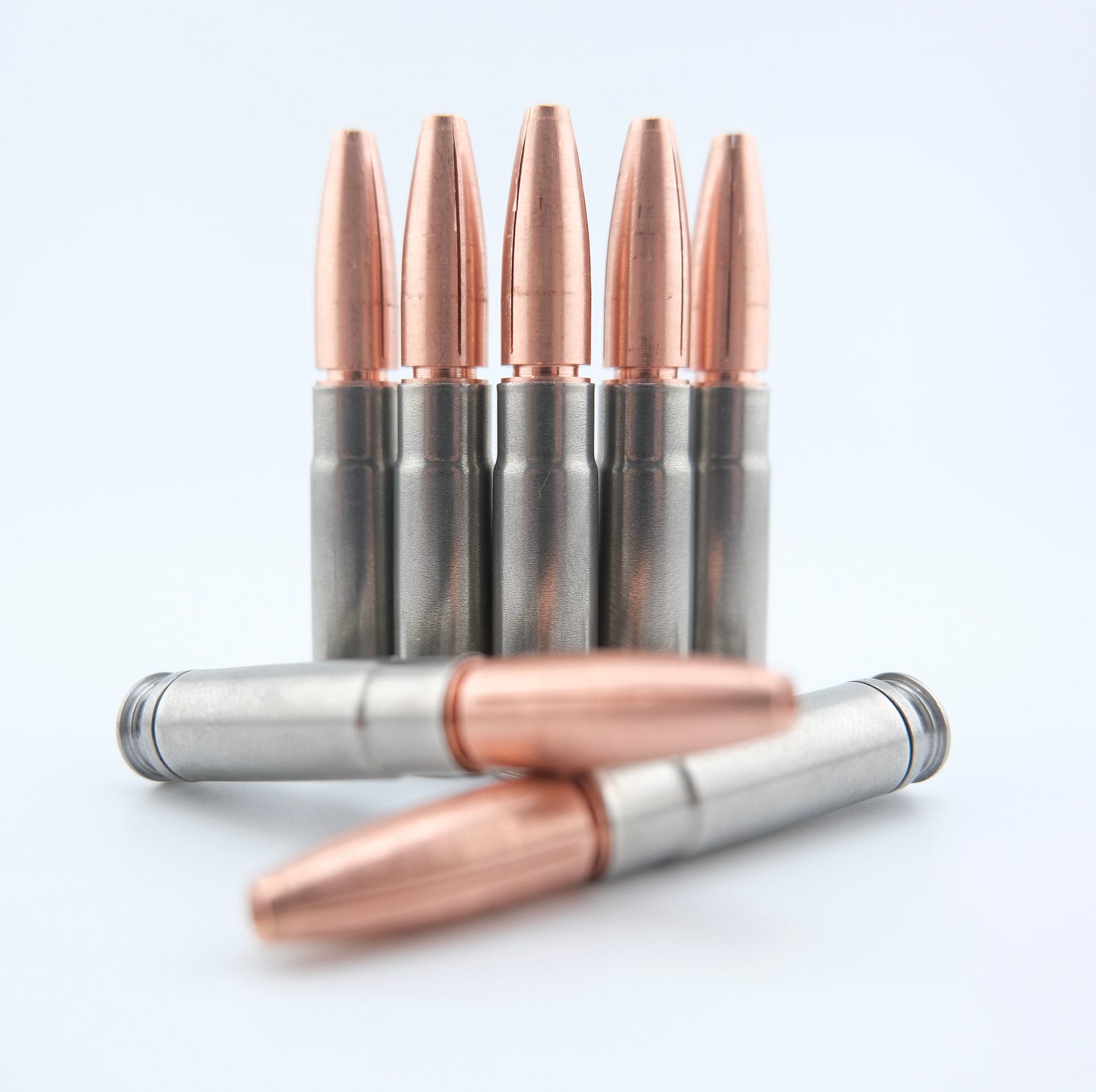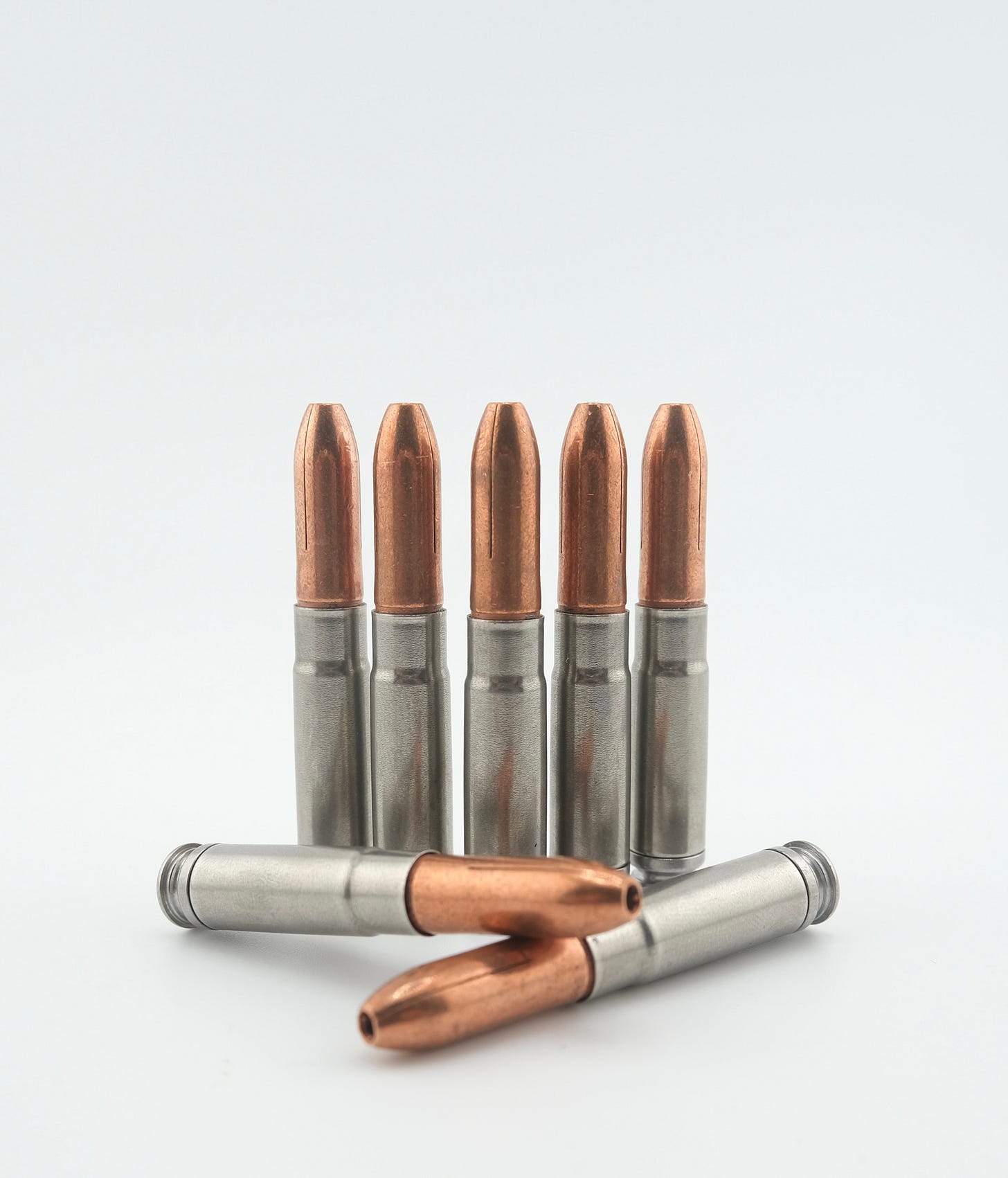Phantom 238 gr and 242 gr 300 Blackout
Posted by Daddy Phantom on Aug 28th 2025
We are announcing the release of two new heavy 300 Blackout subsonic rounds:
300 blk Revenant - 238 Subsonic Fracturing
300 blk Big Brother - 242 Subsonic Expander (replaces 220 gr legacy Big Brother)
Most important information first; We are releasing these Friday, August 29th at 10 AM MST. There will be no need to hide in the bathroom at work to grab some before they sell out. We have a ridiculous amount of these in our inventory ready to go. And they will be produced regularly. We are bringing these rounds to market for performance reasons and also to make our Flagship 300 blk offerings less redundant. Both of these rounds are engineered exclusively for 1:5 twist barrels (slower twist rates may not be able to stabilize them and you risk a baffle strike on your suppressor) and both of these are built from the ground up to maximize what subsonic 300 BLK is capable of.

Heavier subsonic projectiles offer several advantages that make them especially effective in suppressed applications. Their higher ballistic coefficients reduce drag and wind drift. Increased sectional density allows for deeper, straighter penetration, even through bone or intermediate barriers. At subsonic speeds, added mass translates into greater momentum, which improves the reliability of expansion or fracturing mechanisms and helps maintain terminal effect where lighter bullets may fail. When paired with fast twist barrels, heavy projectiles also benefit from higher rotational stress, enhancing stability and ensuring more consistent terminal performance across conditions.
This article is going to dig into each round, speak a little to the differences in terminal mechanisms, and share some of the information we have gathered during the last few months of development and field testing down in south Texas.
The Skinny on these new Fat Ass 300 blk Subs
As we have worked on developing our 405 gr fracturing and 407 gr expanding 8.6 blackout rounds we’ve learned a lot. The development of those rounds is what lead to bringing these 300 blk rounds to market. There were two goals specifically we have been chasing during the development process of these two rounds.
The first goal was to push 300 blackout subs to the absolute limit. There are a ton of 1:5 twist 300 blk barrels on the market (there should be more) and there aren’t any subs designed specifically for those barrels. Nothing that takes full advantage of the faster twist rates. By rolling out these longer, higher bc, heavier subs we are doing just that!
The second objective was to bring a heavy, fracturing subsonic projectile to market. The idea seems obvious in hindsight, but it took seeing the results of our 405 gr 8.6 Blackout subs in 1:3 twist barrels to connect the dots on just how effective the combination of fast twist rates and fracturing subsonic bullets can be. Some of the most devastating exit wounds we have ever observed — from any caliber, subsonic or supersonic — have come from this pairing. With fast twist rates (1:3 for 8.6 BLK, 1:5 for 300 BLK), not only is penetration increased, but the petals that shear away from the base also travel farther laterally than they do with slower twist rates. Designing a 300 BLK subsonic round at the maximum weight and length (for solid a solid copper projectile) for a 1:5 twist barrel, then combining that with a fracturing mechanism, is a natural evolution that makes a great deal of sense.
238 gr Revenant Subsonic Fracturing Projectile

The 238 gr Revenant is a proprietary design, derived directly from our 8.6 Blackout Revenant program. It is purpose-built for fast twist barrels where rotational velocity can be leveraged for terminal effect. (There’s a lot of debate around rotational velocity and how that contributes to total kinetic energy, please see this article for a more detailed take on that specific argument, we aren’t really going to explore that in this article.)
Terminal mechanism:
On impact, the projectile sheds three copper petals that radiate outward.
The base continues linearly, penetrating deeply and often exiting. We shot a dozen or so pigs down in south Texas this past week. We didn’t recover a single base inside a pig during autopsy, they all had (probably) exited.
The result is a combination of straight-line penetration plus multiple secondary wound tracks, producing lateral trauma not normally associated with subsonic ammo.
Field testing in South Texas confirmed what our gel tests suggested. In several cases, petals themselves produced exit wounds. The terminal effect is closer in appearance to what one expects from supersonic ammunition, but delivered at subsonic speeds with full mass retention of the base. When observed in gel this round is capable of producing a temporary wound cavity much larger than expanders, often producing sonoluminescence, which is the phenomenon where the temporary wound cavity (or bubble) collapses under acoustic pressure and emits flashes of light, a process involving extreme temperatures and pressures within the bubble/ wound cavity. Is this indicative of more effective transfer of kinetic energy into the target? Maybe. It does look awesome though, like the mini explosion you normally see with supersonic ammo. This is a good time to remind folks that the primary component of terminal performance is shot placement. You’ll see that emphasized a handful of times more throughout the article.
This 238 grain round exists because fast twist + fracturing design is an impressive pairing. Expect to see a lot of other manufactures roll out fracturing designs trying to keep up. The higher spin rates of 1:5 barrels ensure that petals shed consistently and predictably, turning what is usually a simple wound track into multiple damaging paths.
We are measuring the G1 BC of this round at 0.532.
242 gr Big Brother Expander

The new 242 gr Big Brother replaces our legacy 220 gr load. This round is one we are so excited about. Here we are offering a heavier, harder-hitting option for fast twist platforms that provides the expansion and accuracy we all know and love. This round is the king of expanding subsonic 300 blackout.
Terminal mechanism:
Expands reliably at subsonic velocities into a wide cutting diameter.
Retains all 242 grains for deep penetration.
Produces consistent pass-throughs and devastating exit wounds.

In testing, every recovered projectile displayed perfect expansion geometry. On feral hogs, the results were predictable: large wound channels, reliable pass-throughs, and consistent performance across a variety of shot angles. This is another projectile that is hard to recover. It doesn’t matter where you shoot a pig, it’s probably going out the other side.
The move from 220 gr to 242 gr is deliberate. The gap between 200 gr (Slow Papi) and 220 gr was too small to justify keeping both. Slow Papi outperformed 220 gr in most platforms, so the 220 has been retired. By stepping up to 242 gr, Big Brother now occupies the heavy, 1:5-only niche, while Slow Papi remains the versatile all-around expander for 1:7 and 1:8 twist barrels. This 242 grain round truly is a whole different beast than your lighter subsonic 300 blackout options like 190 gr sub x and it closes the gap a little bit on subsonic 338 arc without being as miserable to shoot. With a G1 BC of 0.531 this round fights the wind and maintains an efficient flight just like the Revenant Fracturing design.
Conclusions
Ultimately when choosing between the two of these it comes down to your preference in terminal mechanism. It may be appropriate to compare the 238 gr fracturing projectile design to a expanding broadhead, while the 242 grain expanding projectile is more like a fixed blade broadhead. Both of these rounds will check the box on the most important terminal indicator, and that is accuracy. It’s just up to the operator to put the bullet on target. Keep an eye out, maybe we will see these in low vis casings at some point down the road.

